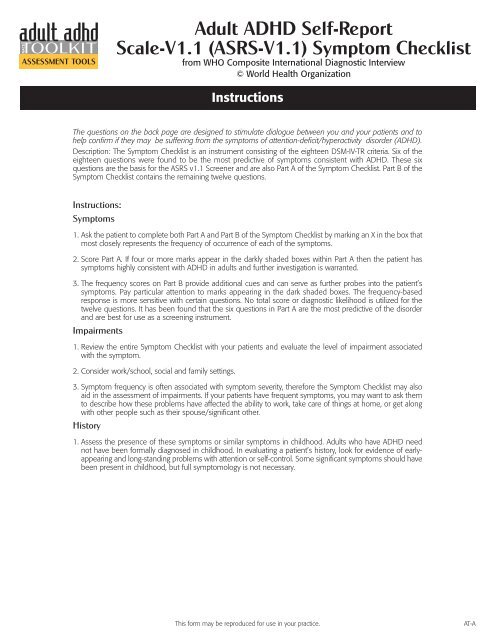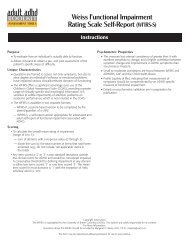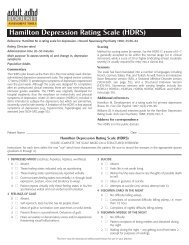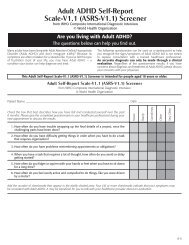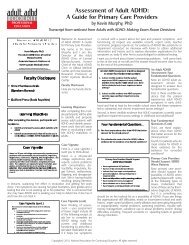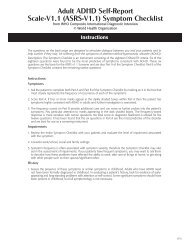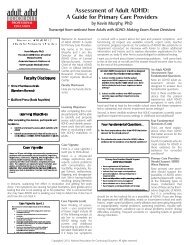A Resource for Clinicians - National Association for Continuing ...
A Resource for Clinicians - National Association for Continuing ...
A Resource for Clinicians - National Association for Continuing ...
You also want an ePaper? Increase the reach of your titles
YUMPU automatically turns print PDFs into web optimized ePapers that Google loves.
ASSESSMENT TOOLSAdult ADHD Self-ReportScale-V1.1 (ASRS-V1.1) Symptom Checklistfrom WHO Composite International Diagnostic Interview© World Health OrganizationInstructionsThe questions on the back page are designed to stimulate dialogue between you and your patients and tohelp confirm if they may be suffering from the symptoms of attention-deficit/hyperactivity disorder (ADHD).Description: The Symptom Checklist is an instrument consisting of the eighteen DSM-IV-TR criteria. Six of theeighteen questions were found to be the most predictive of symptoms consistent with ADHD. These sixquestions are the basis <strong>for</strong> the ASRS v1.1 Screener and are also Part A of the Symptom Checklist. Part B of theSymptom Checklist contains the remaining twelve questions.Instructions:Symptoms1. Ask the patient to complete both Part A and Part B of the Symptom Checklist by marking an X in the box thatmost closely represents the frequency of occurrence of each of the symptoms.2. Score Part A. If four or more marks appear in the darkly shaded boxes within Part A then the patient hassymptoms highly consistent with ADHD in adults and further investigation is warranted.3. The frequency scores on Part B provide additional cues and can serve as further probes into the patient’ssymptoms. Pay particular attention to marks appearing in the dark shaded boxes. The frequency-basedresponse is more sensitive with certain questions. No total score or diagnostic likelihood is utilized <strong>for</strong> thetwelve questions. It has been found that the six questions in Part A are the most predictive of the disorderand are best <strong>for</strong> use as a screening instrument.Impairments1. Review the entire Symptom Checklist with your patients and evaluate the level of impairment associatedwith the symptom.2. Consider work/school, social and family settings.3. Symptom frequency is often associated with symptom severity, there<strong>for</strong>e the Symptom Checklist may alsoaid in the assessment of impairments. If your patients have frequent symptoms, you may want to ask themto describe how these problems have affected the ability to work, take care of things at home, or get alongwith other people such as their spouse/significant other.History1. Assess the presence of these symptoms or similar symptoms in childhood. Adults who have ADHD neednot have been <strong>for</strong>mally diagnosed in childhood. In evaluating a patient’s history, look <strong>for</strong> evidence of earlyappearingand long-standing problems with attention or self-control. Some significant symptoms should havebeen present in childhood, but full symptomology is not necessary.This <strong>for</strong>m may be reproduced <strong>for</strong> use in your practice.AT-A


